Pump Handbook by Igor J. Karassik, Joseph P. Messina, Paul Cooper, Charles C. Heald - 3rd edition
Подождите немного. Документ загружается.

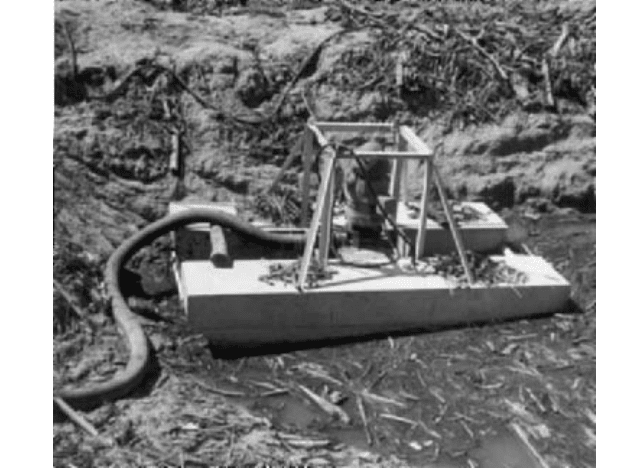
9.198 CHAPTER NINE
FIGURE 1 A simple barge (Hazleton Pumps, Inc.)
mechanical seal. Almost any size can be barge mounted. Figure 2 shows one of three 1500
HP (1119 kW) vertical cantilevered shaft pumps that are installed on one barge. Each
pump is rated at 14,000 gpm (3180 m
3
/h).
Where there is significant rainfall, the flow rates are generally large and the combina-
tion of large capacities with moderate heads may suggest a double suction pump.The selec-
tion of a double suction pump may permit the use of a higher speed pump; however, the
selection may not be based on hydraulic considerations alone.An examination of hydraulic
design for a double suction pump may show it is ideal for a barge-mounted vertical pump,
providing there is ample water level in the pit. On the other hand, minimum water levels
may be required to facilitate mining operations. If these conditions exist, which commonly
occurs, selection of a top inlet single stage pump may be better. Top inlet barge mounted
vertical pumps can pump the water level down without drawing the mud from the bottom.
This is the conflict, as the desirable features of the double inlet pump are lost.
Comparative features can be readily seen from an examination of the net positive suc-
tion head (NPSH) requirements. High-capacity moderate head pumps have a specific
speed (N
S
) which may require a greater NPSH; that is, a greater submergence. This may
alter the pump length and the ability to utilize a cantilevered shaft pump. Such pumps are
ideal for barge mounting if the NPSH (required submergence) conditions exist.
Figures 3 and 4 are reproductions of charts published by the Hydraulic Institute. An
example will highlight the available design choices. Calculations may show that some
combinations of flow, head, and pump speed are not feasible. This is an important consid-
eration before proceeding with design. Assuming we have a possible floating pump station
with a pumping requirement of 7500 gpm (1700 m
3
/h) and a calculated discharge head of
300 ft (91m), Table 1 shows the calculation of the required absolute suction conditions.
Converting from absolute pressure to submergence from the water level to the impeller
centerline, under standard atmospheric conditions, the table shows how much submer-
gence is required for a given operating speed. The table shows that a single inlet pump at
1800 rpm is not practical, and a pump designed for 1200 rpm is barely acceptable. A dou-
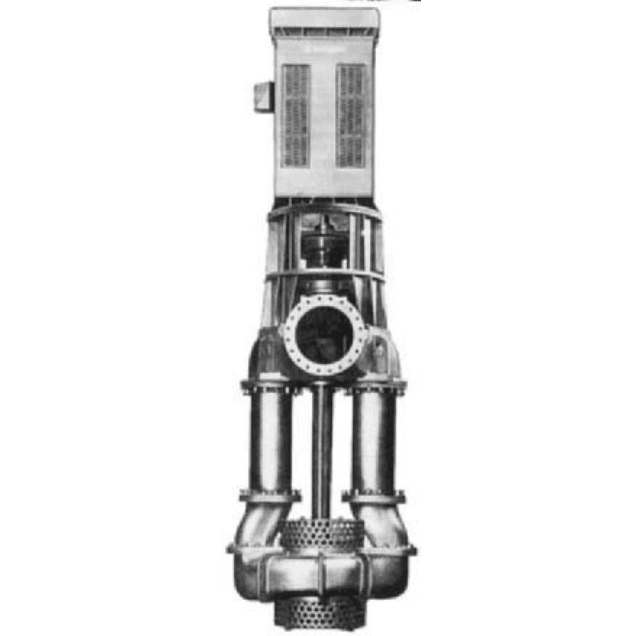
9.10 MINING 9.199
FIGURE 2 Vertical cantilevered shaft pumps used for barge mounting (Hazleton Pumps, Inc.)
ble suction pump at 1800 rpm is also barely acceptable if there is to be a cushion for low
barometer days. A double suction pump at 1200 prm is fully acceptable. We are not locked
into this selection, as a lower flow rate with more pumps may be fully acceptable at a
higher speed.
The calculation for NPSH shows that the 1800 rpm double suction pump and the 1200
rpm single suction pump have about the same NPSH requirement. Although both are for
the same hydraulic conditions, they are substantially different pumps. If the NPSH
requirements can be met with a simple single inlet higher-speed barge mounted pump
installation, a substantial reduction in cost and weight is possible.
Technically, other solutions are possible when the NPSH is marginal. If the NPSH
requirement is only a few additional feet, it may be possible to lengthen the pump to
increase the submerged depth. In comparing available NPSH and required NPSH, the
altitude of the installation and the temperature of the liquid should be considered. Alti-
tude correction can be simply applied as 1 ft (0.3 m) for each 1000 ft (305 m) of elevation
in the calculation of NPSH available.
The development of large overhung vertical shaft pumps has been a boon to mining
operations. Figure 5 shows the installation of four floats, each with a 400 HP (300 kW) top
inlet cantilevered shaft pump. The type of mining operation frequently dictates the pump
design and particularly the installation. Figure 6 shows float mounted pumps designed to
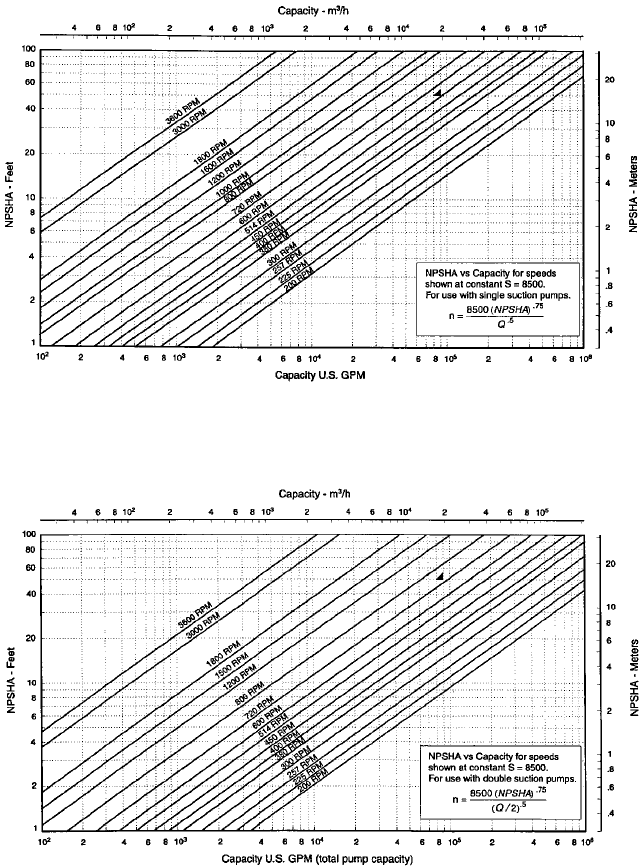
9.200 CHAPTER NINE
FIGURE 4 Recommended maximum operating speeds for double suction pumps (Hydraulic Institute ANSI/HI
2000 Edition Pump Standards, Reference 1)
skim the clean liquid in a settling pond. The float construction acts as a weir so only the
cleanest liquid is returned to the plant. The float mounts 250 HP (185 kW) top inlet verti-
cal cantilevered shaft pumps. An interesting feature is the hydraulic thrust balancing by
the use of opposed flexible hose discharge lines. Note that these forces also exist in steel
pipeline and must be adequately restrained.
FIGURE 3 Recommended maximum operating speeds for single suction pumps (Hydraulic Institute ANSI/HI
2000 Edition Pump Standards, Reference 1)
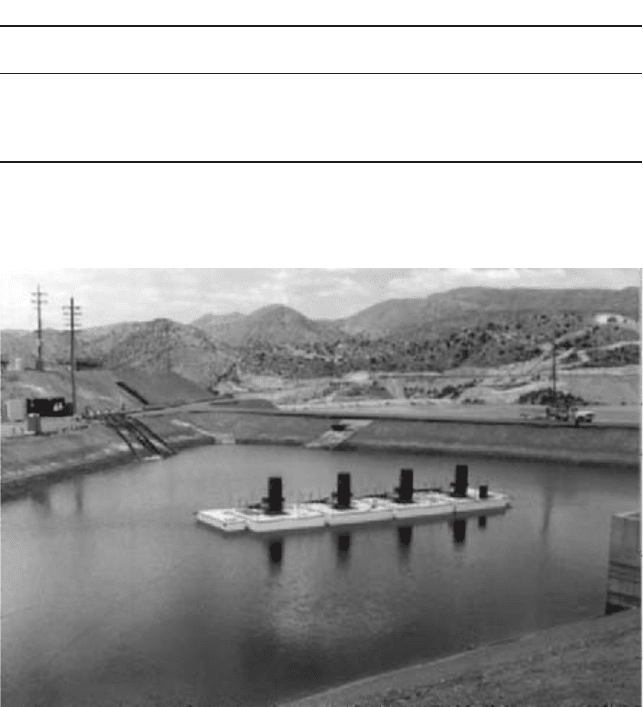
9.10 MINING 9.201
TABLE 1 Calculation of required absolute suction conditions
Pump Type Operating Specific NPSH Required Submergence
Speed
—
rpm Speed Ft (m) Ft (m)
Single Suction* 1800 2163 48 (14.6) 18 (5.5)
Single Suction* 1200 1529 30 (9.1) 0**
Double Suction 1800 1442 31 (9.5) 1 (0.3)***
Double Suction 1200 1019 18 (5.5) 0***
*Can be top or bottom inlet
**Barely acceptable with submergence sufficient to prevent vortexing at inlet
***Very safe
FIGURE 5 An installation of four floats with top inlet cantilevered shaft pumps (Hazleton Pumps, Inc.)
Figure 7 illustrates an interesting installation of a float-mounted pump of unique
design. The pump is of cantilevered shaft design (no submerged bearings) with the pump
utilizing the motor bearings. Pump construction is shown in Figure 8. This is ideal for
barge mounting. It involves a special motor, but the lower center of gravity permits a
smaller barge and readily compensates for the extra cost of the motor. No submerged
shaft bearing is required, so dirty water can be handled with little maintenance. A dou-
ble discharge design also provides balanced hydraulic side thrust and eliminates the
need for a shaft seal.
If floats are to be used for pump mounting, considerations in addition to hydraulics
must be examined. Floats must be designed for safe operation in all circumstances.
Floats for individual pumps are simple and readily moved about a mining operation;
however, there are other factors beside the weight of the pump and motor. A portion of
the discharge line (usually a hose on floats) must be supported by the pump float. Con-
sideration must be given to the possibility that a number of workmen might gather at
one side of the float and overturn it. Stability calculations must be made by considering
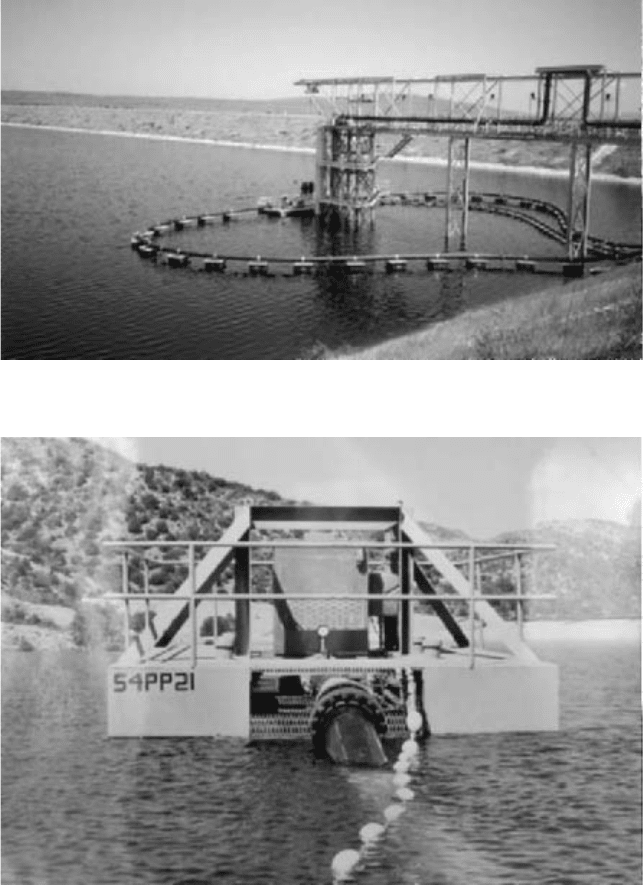
9.202 CHAPTER NINE
FIGURE 6 Float-mounted pumps designed to skim the clean liquid in a settling pond (Hazleton Pumps, Inc.)
FIGURE 7 Unique design float-mounted pump (Hazleton Pumps, Inc.)
lateral rotation of the float and the uprighting forces due to the additional buoyancy on
one side (or end). The center of gravity must be within the center of buoyancy. If the cen-
ter of gravity moves beyond the center of buoyancy, the float will overturn. It must also
be remembered that, after a pontoon is submerged, that is the limit of buoyancy. In addi-
tion to these factors, wind effects must be considered. If the climate is not too severe,
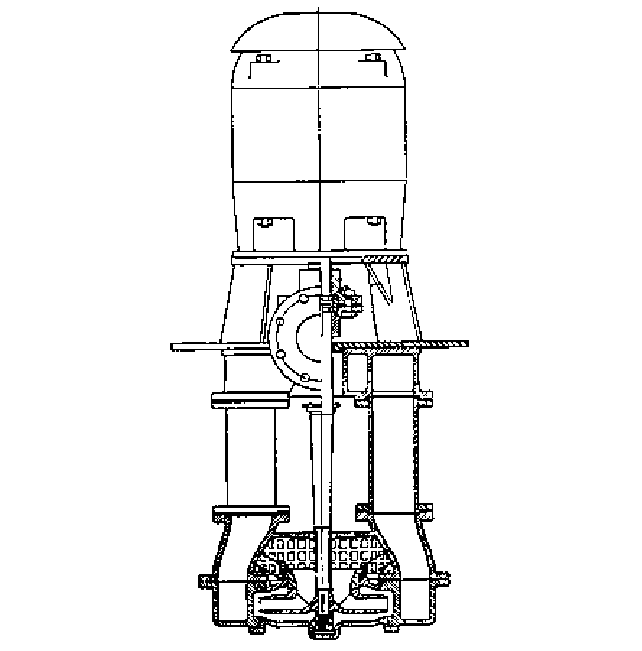
9.10 MINING 9.203
FIGURE 8 Cantilevered shaft design utilizing motor bearings (Hazleton Pumps, Inc.)
pumps on simple floats can be protected from ice damage if the float is surrounded with
a simple air bubble system.
As the pump flow rates increase, fixed installations become more manageable. Figure
9 shows four 24 in (610 mm) discharge, 1250 horsepower (750 kW) vertical pumps. The
pumps are of stainless steel in a mining operation. This is an ideal installation as a struc-
ture is in place for pump maintenance.
The selection of the discharge line will have a significant effect on the total pumping
output. If selected for normal pumping conditions, the pipeline may not add significant
capacity to the system by the use of an additional pump. As an example, examine an
installation utilizing a 14 in (355 mm) Schedule 40 steel pipe discharge line for a normal
flow of about 5000 gpm (1135 m
3
/h). Assume a friction head of 70 ft (21.3 m) and a static
head of 180 ft (54.9 m), for a total pumping head of 250 ft (76.2 m). Figure 10 shows that
adding a second pump to the system will not double the pumping capacity as the two
pump characteristics are added to the system head curve. In this exaggerated example,
adding a second pump will increase the total flow by less than 1000 gpm (227 m
3
/h). Note
that each pump now will discharge less than 3000 gpm (680 m
3
/h). The obvious answer is
to either use a larger discharge line and a different pump selection, or the use of a sepa-
rate discharge line for each pump. In that case, the total capacity would be 10,000 gpm
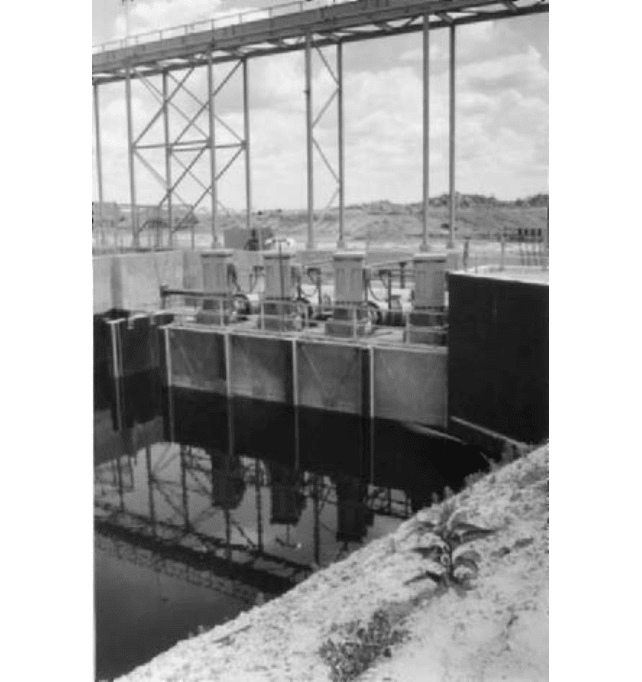
9.204 CHAPTER NINE
FIGURE 9 24 in (610 mm) discharge, 1250 HP (750 kW) vertical pumps (Hazleton Pumps, Inc.)
(2270 m
3
/h). This becomes a study in economics for each installation. In the above exam-
ple, this installation is obviously poorly designed. As pipeline velocities increase, discharge
line transients may present problems on shutdown. The author is aware of one long
pipeline that failed in 17 places on the first shutdown. Other factors must also be consid-
ered, such as the projected life of the project and the cost if the project is flooded.
Much has been said about pumping from mines. Obviously, the least costly method is
to keep the water from entering the mining operation. It is not always applicable, but a
ring of “deep-well” turbine pumps, on the periphery of the operation, can lower the water
table sufficiently to keep the mining pit relatively dry. A typical large turbine pump with
submersible motor is shown in Figure 11.
Pumps for operation in deep mines have different considerations. If a mine is not more
than approximately 1200 ft (365 m) deep, Schedule 40 pipe is generally satisfactory for the
pressure involved. For example, 12 in (305 mm) seamless Schedule 40 steel pipe is listed
as 1200 lb/in
2
(82.75 bar) hydrotest pressure. However, if the water is corrosive, wall thick-
ness allowance must be made, or stainless steel pipe used. 1200 lb/in
2
converts to approx-
imately 2700 ft of water. Allowance must also be made for water hammer if the line
velocity is high. Generally, average line velocities of 10 ft/s (3.1 m/s) will produce high tran-
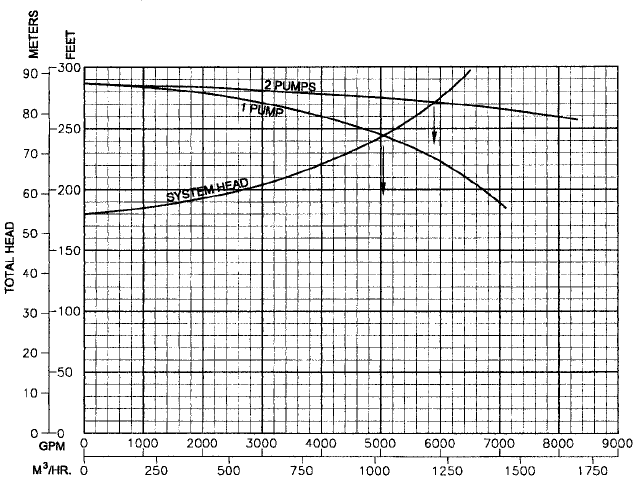
9.10 MINING 9.205
FIGURE 10 One and two pump operation on a system curve
sient pressures upon pump shutdown, so more conservative velocities should be selected.
As these installations are generally long term, considerable savings can be obtained by
reduced power requirements if the pipeline velocities are near 5 ft/s (1.5 m/s).
In designing a mine pumping system, an analysis must be made where the water is
coming from. It is generally not practical to put the main pump station at the bottom of the
mine if the bulk of the water is occurring at an upper level. If this is the case, a decision
must be made for the pumping condition of the mine bottom pumps. Should they simply
pump to the upper level or directly to the surface? Both financial and safety considerations
are essential. Failure of upper level pumps may jeopardize the mine safety. These are deci-
sions that involve much more than basic equipment selection. One solution to the problem
of a possible power failure is the use of submersible pumps at the shaft bottom. Single-
stage submersible pumps, as shown in Figure 12, are available to 600 HP (448 kW) and
can readily pump to upper levels in case of flooding at the bottom level.
If the mine is deeper than 1200 ft (365 m), other approaches must be considered. Con-
sideration of Class 250 or 300 valves and pipefittings may show that the cost warrants
pumping only to an upper level to stay within the limits of the Class 150 fittings. This does
not necessarily mean a duplicate pumping station as series pumps can safely be installed
at an upper level. This is practical only if the bulk of the water occurs at or near the bot-
tom level. Because there are mines deeper than 2000 ft (365 m), the problems become
more acute. In any event, the main consideration is to conduct a study to determine at
what level the greatest flow of water occurs.
A very old but interesting photo (see Figure 13) shows a sealed pump-room housing
three 1000 HP (746 kW) bronze constructed pumps in a coal mine. This pump room had
access only from an upper level so water could rise in the mine by approximately 200 ft
(36.5 m) before flooding the pump room.
Not all mines suffer from ingress of a great deal of water, but many of those that do
have closed because the cost of pumping was too great. An example is shown in Figure 14.
There were three 2000 HP (1490 kW) pumps in one pump room in a zinc mine. Note in this
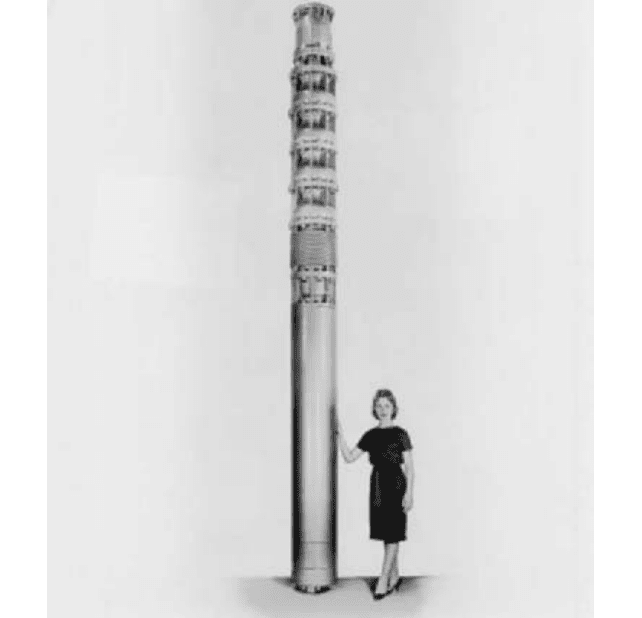
9.206 CHAPTER NINE
FIGURE 11 A typical large turbine pump with submersible motor (Hazleton Pumps, Inc.)
photograph that these large pumps are in segments so they can be lowered into the mine
and reassembled.
Pump discharge line forces must be calculated for all installations.The reactive forces
from the piping must be isolated from the pump. Underground pumps generally operate
at high pressure and the forces generated are high. Failure to adequately support and
restrain the piping can cause pipe failure and result in severe pump misalignment.
MATERIALS OF CONSTRUCTION _______________________________________
Most water pumps perform quite satisfactorily with bronze impellers, wearing rings, and
shaft sleeves, but the dirty or corrosive waters in mine service require superior materials.
Because mine waters range from neutral (pH of approximately 7) to severely acidic (as low
as pH 1.5 in some coal mines) and to very basic (as occurs in limestone mines and so on),
there is no universally best material. The choice obviously is the lowest-priced material
that gives satisfactory service life.
Many times, the decision must be made not on the basis of the best available materi-
als, but on the basis of which material will best withstand the abrasive conditions during
the intended life of the project. If there is a five-year anticipated life of the mine, there is
little advantage in selecting materials that will last twice as long. Conversely, a mine with
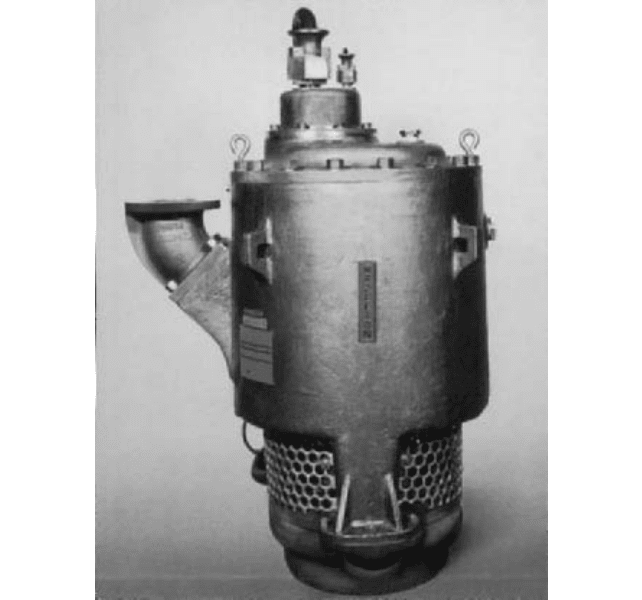
9.10 MINING 9.207
FIGURE 12 Single stage submersible pump (Hazleton Pumps, Inc.)
a projected life of 25 years would require the best commercially available materials. There
are also the exotic alloys, but their use is seldom justified.
Assuming that there will always be a slight amount of solids present, the metallurgy
given in Table 2 should be considered.
Care should be exercised when selecting alloys because many stainless steels do not
have as great a strength as carbon steel. The same applies to bolting. Thus, a pump rated
for high-pressure service with a carbon steel or alloy steel casing and bolting may not be
suitable when made of bronze or stainless steel.
Although ceramic-coated shaft sleeves are excellent in many applications, remember
that ceramic coatings are porous and that the base metal must be able to withstand the
environment. Also, some ceramics will not be suitable in strongly basic water. Others, how-
ever, are suitable, and so a general specification for ceramic coating should never be made.
A plasma-applied ceramic is generally denser and more serviceable than one applied by a
simple flame spray.
HYDRAULIC CONDITIONS _____________________________________________
Low-Head Pumps
For low-head pumps, up to approximately 150 ft (46 m), the instal-
lation must be carefully checked to prevent cavitation during periods of low-head opera-
tion. This is particularly important during one-pump operation on a parallel system. For
